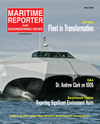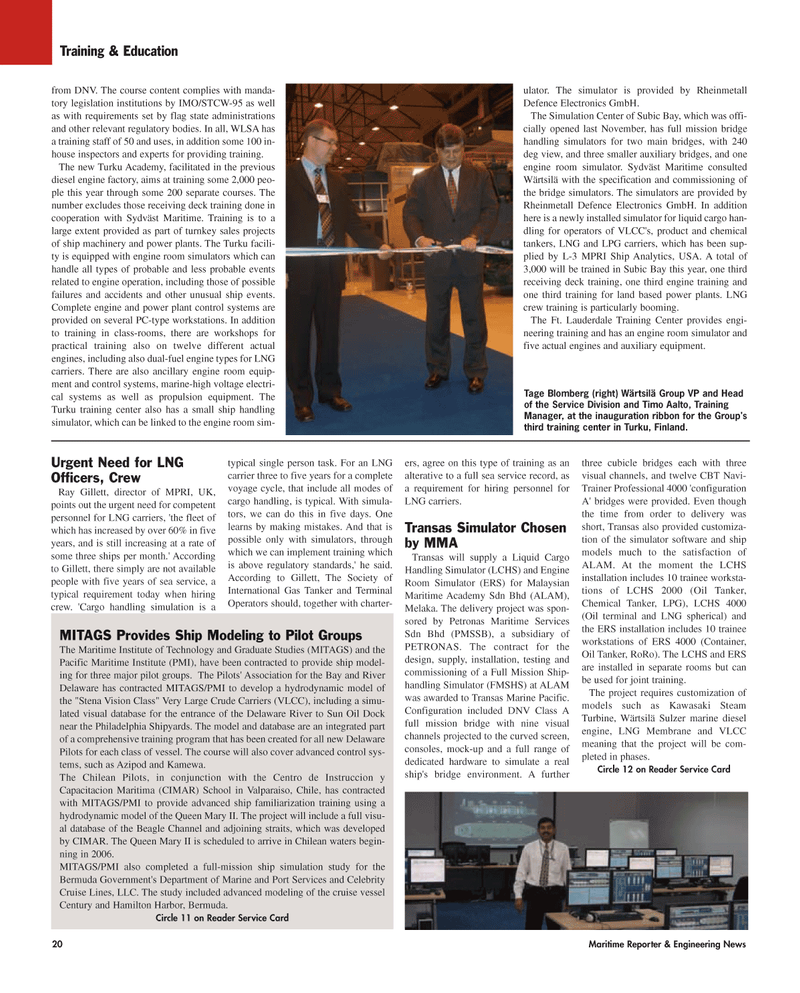
Page 20: of Maritime Reporter Magazine (March 2006)
The Training & Education Edition
Read this page in Pdf, Flash or Html5 edition of March 2006 Maritime Reporter Magazine
Training & Education 20 Maritime Reporter & Engineering News from DNV. The course content complies with manda- tory legislation institutions by IMO/STCW-95 as well as with requirements set by flag state administrations and other relevant regulatory bodies. In all, WLSA has a training staff of 50 and uses, in addition some 100 in- house inspectors and experts for providing training.
The new Turku Academy, facilitated in the previous diesel engine factory, aims at training some 2,000 peo- ple this year through some 200 separate courses. The number excludes those receiving deck training done in cooperation with Sydväst Maritime. Training is to a large extent provided as part of turnkey sales projects of ship machinery and power plants. The Turku facili- ty is equipped with engine room simulators which can handle all types of probable and less probable events related to engine operation, including those of possible failures and accidents and other unusual ship events.
Complete engine and power plant control systems are provided on several PC-type workstations. In addition to training in class-rooms, there are workshops for practical training also on twelve different actual engines, including also dual-fuel engine types for LNG carriers. There are also ancillary engine room equip- ment and control systems, marine-high voltage electri- cal systems as well as propulsion equipment. The
Turku training center also has a small ship handling simulator, which can be linked to the engine room sim- ulator. The simulator is provided by Rheinmetall
Defence Electronics GmbH.
The Simulation Center of Subic Bay, which was offi- cially opened last November, has full mission bridge handling simulators for two main bridges, with 240 deg view, and three smaller auxiliary bridges, and one engine room simulator. Sydväst Maritime consulted
Wärtsilä with the specification and commissioning of the bridge simulators. The simulators are provided by
Rheinmetall Defence Electronics GmbH. In addition here is a newly installed simulator for liquid cargo han- dling for operators of VLCC's, product and chemical tankers, LNG and LPG carriers, which has been sup- plied by L-3 MPRI Ship Analytics, USA. A total of 3,000 will be trained in Subic Bay this year, one third receiving deck training, one third engine training and one third training for land based power plants. LNG crew training is particularly booming.
The Ft. Lauderdale Training Center provides engi- neering training and has an engine room simulator and five actual engines and auxiliary equipment.
Tage Blomberg (right) Wärtsilä Group VP and Head of the Service Division and Timo Aalto, Training
Manager, at the inauguration ribbon for the Group's third training center in Turku, Finland.
Urgent Need for LNG
Officers, Crew
Ray Gillett, director of MPRI, UK, points out the urgent need for competent personnel for LNG carriers, 'the fleet of which has increased by over 60% in five years, and is still increasing at a rate of some three ships per month.' According to Gillett, there simply are not available people with five years of sea service, a typical requirement today when hiring crew. 'Cargo handling simulation is a typical single person task. For an LNG carrier three to five years for a complete voyage cycle, that include all modes of cargo handling, is typical. With simula- tors, we can do this in five days. One learns by making mistakes. And that is possible only with simulators, through which we can implement training which is above regulatory standards,' he said.
According to Gillett, The Society of
International Gas Tanker and Terminal
Operators should, together with charter- ers, agree on this type of training as an alterative to a full sea service record, as a requirement for hiring personnel for
LNG carriers.
Transas Simulator Chosen by MMA
Transas will supply a Liquid Cargo
Handling Simulator (LCHS) and Engine
Room Simulator (ERS) for Malaysian
Maritime Academy Sdn Bhd (ALAM),
Melaka. The delivery project was spon- sored by Petronas Maritime Services
Sdn Bhd (PMSSB), a subsidiary of
PETRONAS. The contract for the design, supply, installation, testing and commissioning of a Full Mission Ship- handling Simulator (FMSHS) at ALAM was awarded to Transas Marine Pacific.
Configuration included DNV Class A full mission bridge with nine visual channels projected to the curved screen, consoles, mock-up and a full range of dedicated hardware to simulate a real ship's bridge environment. A further three cubicle bridges each with three visual channels, and twelve CBT Navi-
Trainer Professional 4000 'configuration
A' bridges were provided. Even though the time from order to delivery was short, Transas also provided customiza- tion of the simulator software and ship models much to the satisfaction of
ALAM. At the moment the LCHS installation includes 10 trainee worksta- tions of LCHS 2000 (Oil Tanker,
Chemical Tanker, LPG), LCHS 4000 (Oil terminal and LNG spherical) and the ERS installation includes 10 trainee workstations of ERS 4000 (Container,
Oil Tanker, RoRo). The LCHS and ERS are installed in separate rooms but can be used for joint training.
The project requires customization of models such as Kawasaki Steam
Turbine, Wärtsilä Sulzer marine diesel engine, LNG Membrane and VLCC meaning that the project will be com- pleted in phases.
Circle 12 on Reader Service Card
MITAGS Provides Ship Modeling to Pilot Groups
The Maritime Institute of Technology and Graduate Studies (MITAGS) and the
Pacific Maritime Institute (PMI), have been contracted to provide ship model- ing for three major pilot groups. The Pilots' Association for the Bay and River
Delaware has contracted MITAGS/PMI to develop a hydrodynamic model of the "Stena Vision Class" Very Large Crude Carriers (VLCC), including a simu- lated visual database for the entrance of the Delaware River to Sun Oil Dock near the Philadelphia Shipyards. The model and database are an integrated part of a comprehensive training program that has been created for all new Delaware
Pilots for each class of vessel. The course will also cover advanced control sys- tems, such as Azipod and Kamewa.
The Chilean Pilots, in conjunction with the Centro de Instruccion y
Capacitacion Maritima (CIMAR) School in Valparaiso, Chile, has contracted with MITAGS/PMI to provide advanced ship familiarization training using a hydrodynamic model of the Queen Mary II. The project will include a full visu- al database of the Beagle Channel and adjoining straits, which was developed by CIMAR. The Queen Mary II is scheduled to arrive in Chilean waters begin- ning in 2006.
MITAGS/PMI also completed a full-mission ship simulation study for the
Bermuda Government's Department of Marine and Port Services and Celebrity
Cruise Lines, LLC. The study included advanced modeling of the cruise vessel
Century and Hamilton Harbor, Bermuda.
Circle 11 on Reader Service Card
MR MARCH2006 #3 (17-24).qxd 3/2/2006 11:32 AM Page 20

 19
19

 21
21
